Art World
‘I Say Tear It All Down’: Curator Legacy Russell on How ‘Glitch Feminism’ Can Be a Tool to Radically Reimagine the World
'Glitch Feminism: A Manifesto' aims to serve, she says, as both a "call to action and as a syllabus."

'Glitch Feminism: A Manifesto' aims to serve, she says, as both a "call to action and as a syllabus."

Ben Davis

Legacy Russell doesn’t do things IRL. Throughout her writing, you’ll find instead the term “AFK” (Away From Keyboard).
As the mobile internet became ubiquitous in the early 2010s, theorists talked about the fallacy of “digital dualism,” arguing against the idea that life online was any less authentic than life offline. Russell took this critique and ran with it, celebrating the very “real” potentials and possibilities that digital tools had opened up for queer identity, trans identity, and marginalized people in general.
Russell’s notion of “Glitch Feminism” was, fittingly, launched on the web. She first developed the idea back in 2012 as an essay for the online theory journal the Society Pages, “Digital Dualism and the Glitch Feminism Manifesto.” From there, it took on a life of its own, finding an audience among artists and “digital natives” of all kinds, anthologized and discussed at panels. Now, it has made the jump into book form as Glitch Feminism: A Manifesto, just released by Verso.
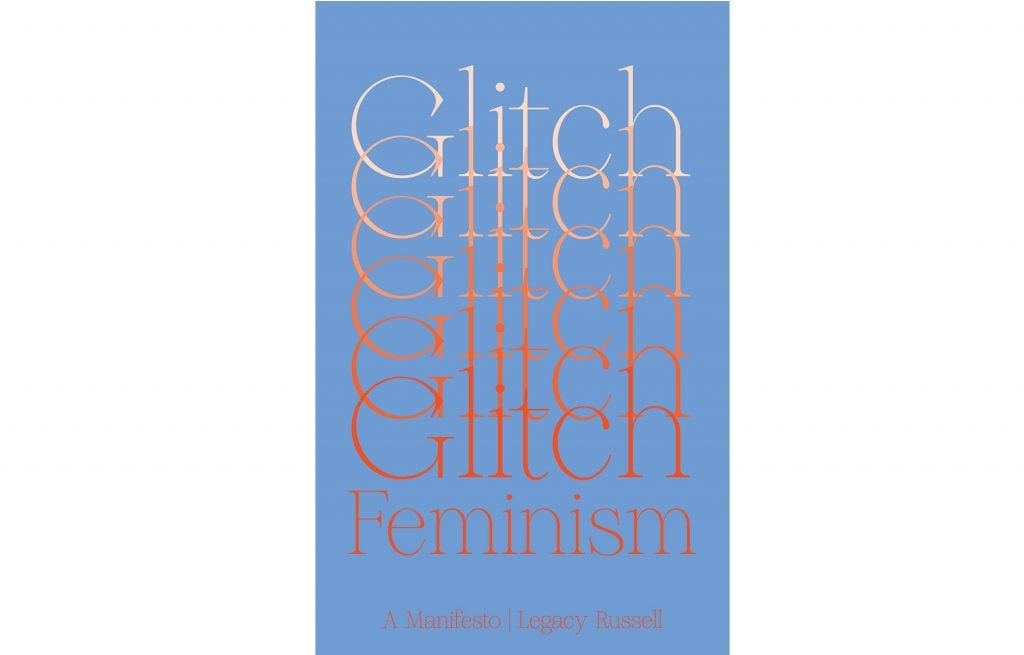
Cover of Glitch Feminism: A Manifesto by Legacy Russell (Verso Books, 2020). Design by Elizabeth Karp-Evans (Pacific).
“USURP THE BODY! BECOME YOUR AVATAR!” the text exhorts its readers. Throughout its pages, Russell, who is also a curator at the Studio Museum in Harlem, tracks the artists and ideas that illustrate the potential of “Glitch Feminism.” I spoke with her recently about the origins of the text, how she squares the manifesto’s optimism with the darker side of tech, and what it means for the book to be coming out in a moment marked by protest and crises, both online and AFK.
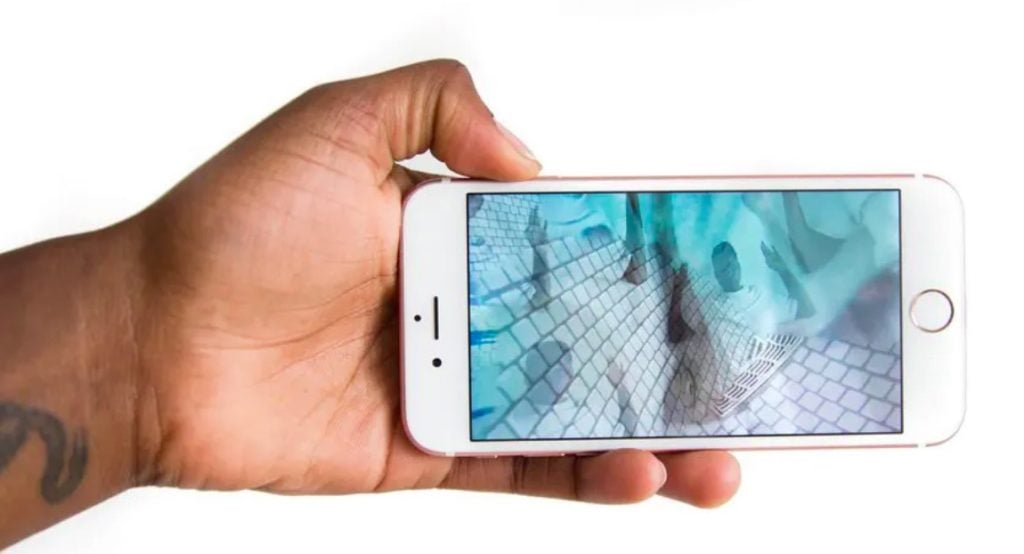
Rindon Johnson, My Daughter, Aaliyah (Norf, Norf) (2016), courtesy of the artist.
What inspired the book? How did you arrive at the concept of Glitch Feminism?
The entry points discussed in the book are very personal: I am a Black, femme, queer woman who grew up in New York City, and had the privilege of being in a city that was incredibly diverse, exciting, and intersectional in so many ways. But at many, many points, the spaces that I traveled through as a kid also felt incredibly alienating. Looking back critically as an adult, it’s been meaningful to reflect on how the digital was a bridge to different types of possibilities in terms of understanding who I could be.
The visibility of Blackness and queerness and femme identity is at historical highs right now—but for the period of time that I was coming up, this was not the case. In over a decade now of being in the art world, I’ve seen how these questions of representation and visibility have remained precarious and complicated.
There’s also the academic side. I think of the sheer number of conferences and panels and symposia and exhibitions that I’ve been to about digital art, moving image art, new media, and internet art. You could probably count on one hand the Black people, people of color, and queer people who are being represented as part of those rosters.
And quite frankly, that made me angry. It made me question, as an art historian, why this story was being told in that way. I think of my peers, the people I have come up with creatively, who are doing incredible work, whom I felt very strongly should be positioned with a greater sense of purpose and clarity across an art historical canon. Why weren’t these conversations being reflected inside of gallery and exhibition spaces and the broader academic discourse?
So the book is a demand to center certain questions tied to what artistry is and who is and is not made visible, looking at art as it exists through, and is inspired by, the internet and digital culture. It’s also about the body and the machine, looking at the generation that came of age in the ’90s, which went online because there were not always physical places that they could safely go to experiment and explore and think about who they wanted to become.
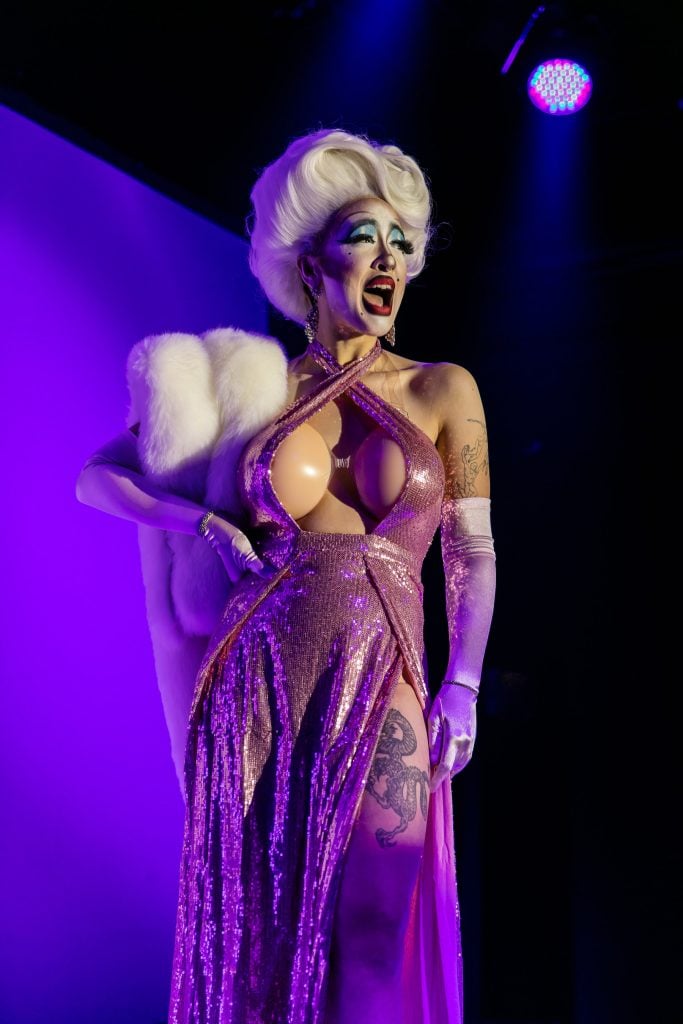
Victoria Sin, performance at “Glitch @ Night” organized by Legacy Russell as part of “Post – Cyber Feminist International,” 2017, ICA London, courtesy of ICA London, photograph by Mark Blower.
You connect it to the earlier moment of ’90s Cyberfeminism. How do you consider what you’re doing as developing or correcting that tradition?
I see Glitch Feminism as a part of that history, for sure. But I also recognize that so many of the primary contributors that come up in relation to Cyberfeminism are cis-gendered white women. So that’s complicated.
This is where I think it’s useful to talk about the personal again. In the early days of grad school, when I was getting my MRes at Goldsmiths or even during my undergraduate study, I’d present papers and research and end up on stage with folks who were absolutely brilliant but really narrow in terms of their understanding of Cyberfeminist history.
So many of the folks I mention in the book have done such important work to broaden the definition of what Cyberfeminism can be. As Black people and queer people, the ways that we have used the internet as a site of collective gathering, as a space for questioning and congregating but also of nightlife and performance—all of those things have been made possible through strands of discourse and theory that I didn’t see represented at all. That was really disappointing to me.
Part of the impetus of this project was asking questions about ways that history can be written for us, by us. I wanted to make something that could live both as a call to action and as a syllabus, bringing together thinkers who are from different generations in one space, but speaking as a chorus, putting forward an idea about what the body can be.
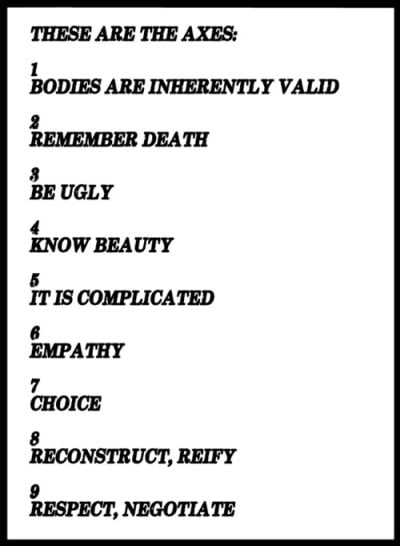
Mark Aguhar, These are the axes (2012). Image courtesy of the estate of Mark Aguhar.
Talk about a couple of the artists that you bring up in the book.
I can’t talk about Glitch Feminism without talking about Mark Aguhar, who passed away in 2012 and was gender queer and both an incredible performance artist and a producer of many different types of texts.
I came across Mark Aguhar’s work in my own late-night surfing of the net, and it’s been a great joy to see it emerge into different places and spaces: some of the work was included in “Trap Door” at the New Museum and then again in the Brooklyn Museum’s “Nobody Promised You Tomorrow.” Mark has an enduring presence across conversations about the digital and queering the body in many different spheres.
The book begins with an homage to Mark’s work, including a 2012 piece called “these are the axes,” which I kept coming back to after I encountered it many, many years ago. It was on my desktop forever. It was the screensaver on my phone. I couldn’t put it down. It brought clarity, a way to be better at celebrating bodies and thinking about what the gender binary is and is not, and how we can maybe resist or refuse it.
Another artist would be Shawné Michaelain Holloway, someone whose work I have now followed for over a decade. She is absolutely phenomenal. It was always so shocking to see so many young, white, Cyberfeminists and net artists be recognized in lots of high-end academic spaces, and Shawné wasn’t there. Yet again we see in these different exhibitions and surveys of “the Internet” that this discourse around the digital is often incredibly problematic, perpetuating—and replicating—all the problems of a white hetero AFK art historical canon.
Shawné is without a doubt one of the most talented artists of this current generation. She’s somebody who is thinking very critically about what performance is on the internet, who has done some incredible work and really thought about ways of pushing back at questions of race and gender, performing different selves as part of a durational presence that exists and is captured through different digital platforms.
There are so many others. Sondra Perry is another artist who is very dear to me, someone who’s grown in leaps and bounds, with great critical success and acclaim, over the past years. She’s somebody bringing important questions about what visibility means. She’s bringing in questions too about manipulating the image, proposing new bodies and creating new relationships between the body and the machine. Sondra also deploys digital material to challenge gender and race, showing us that gender is racialized and race is gendered and that all of this is entangled in this question of “visibility.”
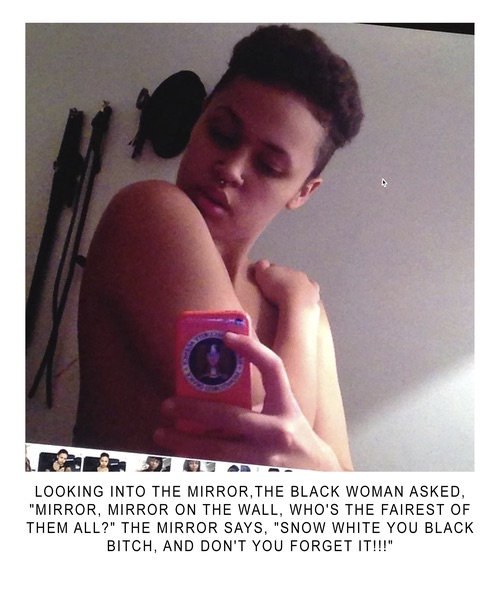
shawné michaelain holloway, mirror-mirror_(newGen_TechEdit)
blackbitch1.png (2015). Image courtesy of the artist.
There’s been a lot of anti-tech sentiment, particularly since Trump’s election. This manifesto really centers the idea of the importance of digital spaces and social media for destroying the gender binary, for creating new kinds of communities, creating new terms of representation. I think that’s really important—but I still do have a question about how it fits with the negative side. Because these digital platforms are still corporate spaces and all the problems of algorithmic control and surveillance and privacy are still there. Do you see that as a contradiction that’s just at the heart of this, or is Glitch Feminism a way of moving beyond it?
I think it’s complicated. I appreciate you asking this question, because I think it’s important to try to navigate.
We’ve known for quite some time that the internet is not a utopia. It began as ARPANET. It had its roots in the military. It has always been used for corporate ends. It has never provided us complete freedom from the kind of challenges that afflict us away from our screens. There are very few people who are making this kind of work who aren’t asking these kinds of questions. I’m thinking about American Artist, who’s in the book, and the incredible work that they’ve done about predictive policing.
So I’m not saying that these challenges don’t exist or that we should not be concerned about them. It’s useful to ask questions about the algorithm—but also, to remember that in the United States of America, every day, when we close our screens and walk around the world, things are equally coded, they’re incredibly violent, the possibility for harm is very high. In a moment where it feels urgent to think about Black and queer lives, femme-identified people, trans lives, it’s really important to still know that there are many, many people who do not feel safe moving around physically in the world.
If we think about the approach to the internet of a book like Sherry Turkle’s Alone Together, the idea that we are isolated on the internet and that it’s difficult to connect and build authentic communities there—that actually only presents one part of the story. Then we have another critical narrative, from someone like Lisa Nakamura, of “identity tourism”—that the internet is a place where we exploit different identities. And there’s still another critical narrative, which focuses on how the internet holds no one accountable. We saw this play out with Gamergate, where digital space allows certain forms of gendered violence to mask themselves.
But for every one of those things, we see an opposite argument. For the question about identity tourism, we see that actually many creative people are using the internet as a means to explore different parts of themselves. Experimenting with other identities is not in and of itself a violence. The violence comes in with the question of deception. We can go back to Irving Goffman’s Presentation of Self in Everyday Life—performativity is part of being human. So the idea that going on the internet is faceless does not necessarily automatically make it sinister.
We can see the same counterpoint when we think about this notion of accountability. With the #MeToo moment, with the Black Lives Matter moment, people are being held deeply accountable by a digital action, right? These are kinds of collective actions, movements that are taking place online, but that are also allowing for different types of political engagement.
For me, the situation doesn’t have to be simple. It can be nuanced and complicated. The hope in writing this book is to think about ways in which, as you said, there is a move beyond two sides. It is not purely that physical space is honest, whereas the internet is a site of deceit. Fetishizing the digital versus the physical in this way does a disservice to the imaginative potential of what worlds we can build therein.
So many of us use the Internet to explore our range. One of my incredible thought partners, McKenzie Wark has built an incredible career grappling with the problems of technology—but also I really appreciate that she has a badass Instagram where she makes space to celebrate, explore, question her own brilliant trans presence and, too, to bring together a community of people who can collectivize in doing that work together to dialogue in allyship and advocacy.
That is important work, especially when we recognize that these are spaces built to share and show what sort of futures we are fighting for. On a daily basis, we are all performing different selves, on and beyond the Internet. It’s important to recognize that this type of exploration can help us center one another; it can help us see ourselves with greater clarity; it can break through very real isolation.
We are told every day, in physical space and otherwise, that we do not have a right to live—and we are going to live anyway. That critical action in itself is part of the bedrock of what Glitch Feminism is aiming to put forward.
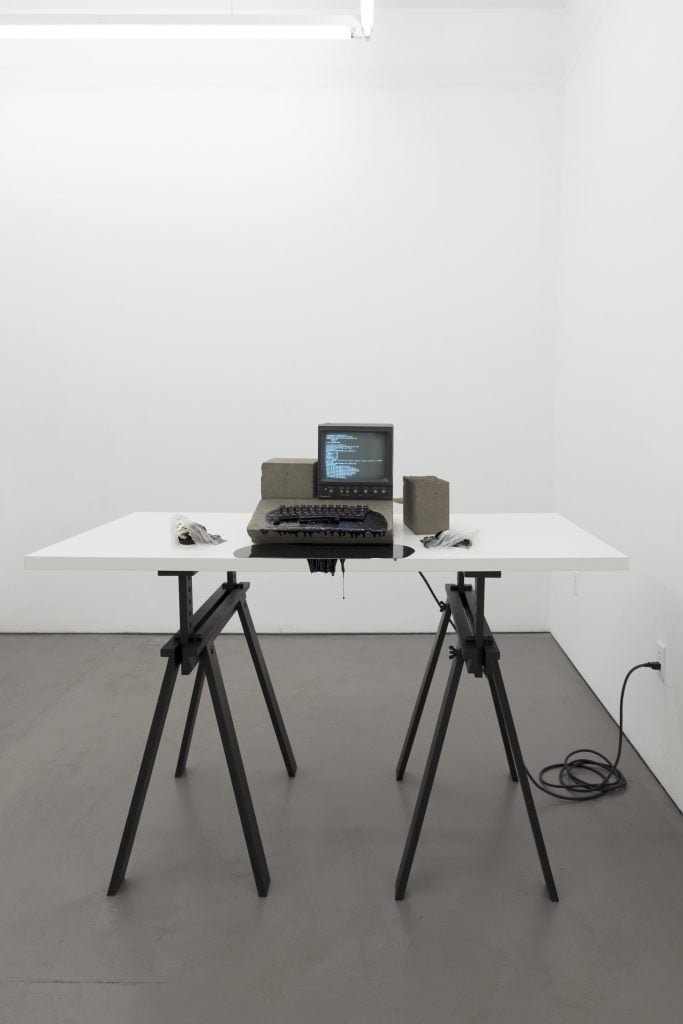
American Artist, American Artist, Mother of All Demos (2018). Image courtesy of HOUSING, Brooklyn.
I wondered if that was part of the symbolic work that “glitch” was doing, taking the argument beyond Cyberfeminism. In one of its strands, Cyberfeminism was very utopian, claiming technology as a vehicle of liberation. The glitch seems to be about inhabiting contradiction: you’re in those spaces, but also looking for the moments where you can turn them against themselves, where they break down.
Absolutely. Glitches are a frustration of the machine, a failure. If you are the user of the machine, they actually will agitate you and cause some discomfort—but that in and of itself is an important place to occupy.
I want to think about the fact that the people themselves—myself included—are the glitch in the system, to ask the question of what it means to be a broken self, to fail in a system that has failed us, rather than to succumb to the pressure to assimilate or conform within a culture that doesn’t love us, a culture that does not recognize our right to live and make a life.
How do we break what is broken? This is a question that has obviously come to the surface for so many people in the last few months. I think it’s an important question to interrogate, to think through what models of “success” are in a culture that continues to center supremacy and enact social and physical death unto those who don’t “fit.”
I say tear it all down—breaking what’s broken is the glitch. It is an abolitionist demand, a demand to get free.
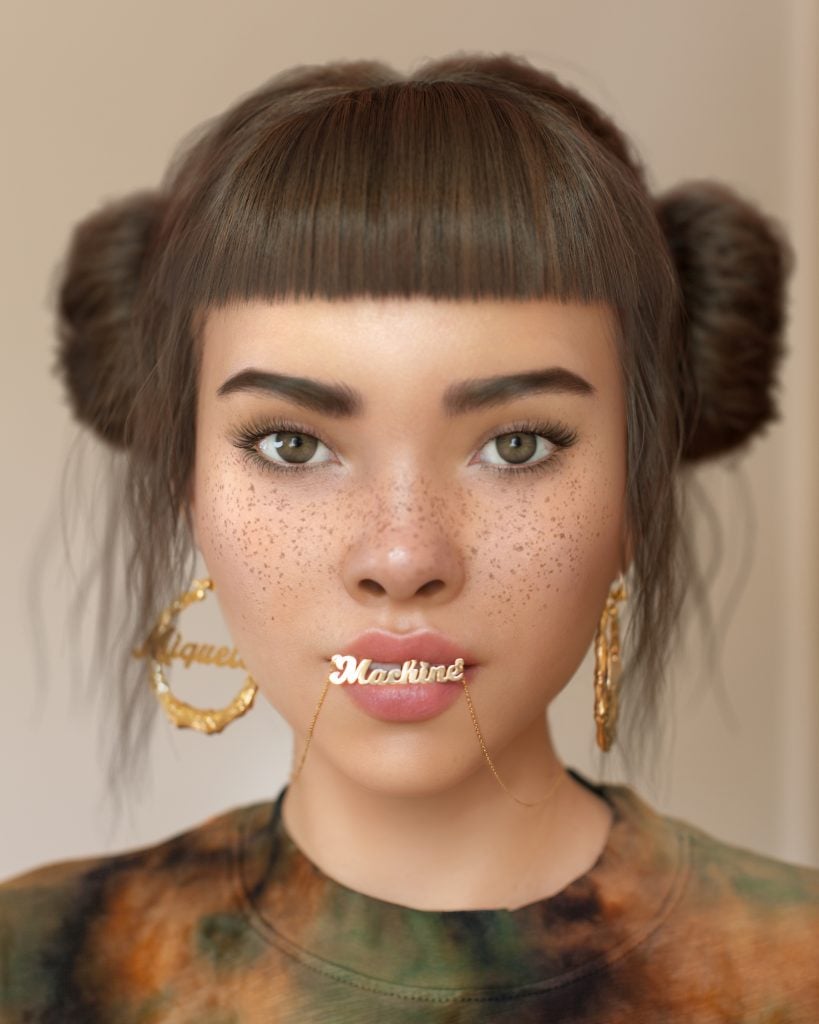
“Digital influencer” Lil Miquela, courtesy of Brud.
You write in the book, “Glitch is anti-body, resisting the body as a coercive social and cultural architecture.” That brought to mind all the discussions since the pandemic about what it means to be an “essential worker,” that it’s actually a privilege to have access to digital work and not have to show up as a body for work. That’s a question that your manifesto opens up for me: How do you balance embracing the liberating possibilities of cyber identity with the realities that some people’s means of survival make those inaccessible?
When someone says to you “body,” what comes to mind? I’ve lectured at different institutions, and it’s always interesting to see how they are or are not defining what a body is. When I’m at the London School of Economics there is one definition, but then you go over to an art space and it’s a whole different kettle of fish. No one comes up with the same idea. So many people bring very real and devastating bias into shaping this “body” and shaping how it should work, who it should serve.
What the book is arguing is that the body is a construct. There are so many different versions of what a body is, and part of the violence we are seeing in this moment right now, especially as tied to Black lives, to trans lives, connects to this notion of who does and does not fit and who is and is not defined or read as human, quite literally. Those decisions are actually a determining factor for making decisions about who has the right to live.
The questions about “essential worker” have become part of this COVID-19 conversation, which is urgent and very important. When you go into Whole Foods, for example, you’re seeing a Black and Brown workforce shopping for groceries for people who are sitting at home. This is plantation capitalism. With Amazon, there’s this notion of it as a faceless force that is too big to break—but who are the physical individuals inside of those warehouses? Those are the people who are putting themselves at risk on a daily basis. These, too, are essential workers.
The challenge is that those individuals have always been there, but not seen. The workforces that are often carrying the burden of these great moments of historical crisis, social and cultural, are Black and Brown people. They are taking care of your grandmother at the hospital. They are the people who are delivering your groceries. And those are individuals who are rendered invisible by the broader systems of capitalism and economy that exist in America and the world today.
So I think it’s complicated. This notion of “anti-body” is not intended to erase; it’s about raising the question of who is and is not visible, challenging people to think about what their definitions are. It’s about recognizing that the term “body” as entangled with a discussion of what is and is not “human,” is gendered, and racialized—and too often it is Black bodies, femme bodies, queer bodies that are rendered invisible by machinic systems.
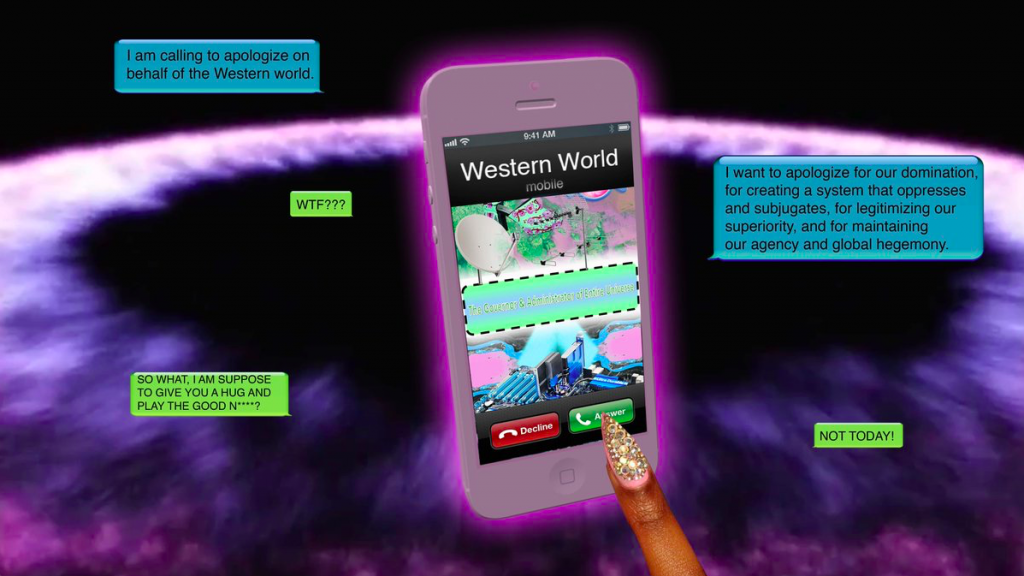
Still from Tabita Rezaire, Afro – Cyber Resistance (2014). Image courtesy of the artist.
Now is a really crucial moment for a Glitch Feminism Manifesto to come out. You started the project back in 2012—so much has changed since then, and so much just in the last couple of months. Do any of these changes shift the way you think about this theory or where it fits in?
I’ll be completely frank with you: recent events have been staggering. I wouldn’t have wished these events on the world. But I also think it could not be a better time to be talking about some of these questions, given everything that’s going on.
It’s been quite surreal. The context that the text rose out of was deeply personal. It began with conversations in my community, looking at notions of identity and representation, looking at different utopian demands, thinking about ways where we might make a different type of presence for ourselves felt. But in a moment like the present, which involves an incredible confluence of different types of crises, the questions in the book bleed into the rest of the world in all of these different ways.
I feel like I’ve written 20 books in writing the one. There are moments across those pages where I have just ranted. Moments where I have despaired. Moments of great optimism.
Aspects of the world have been changing so fast that it was hard at points to think about what needed to be pinned down and what needed to be allowed to change as the world changed. To me, the constants were the artists and the artwork that I discuss. They allow for certain types of constant engagement, that can be set against these broader world events.
In thinking about how this work lives on, my hope is that it can be a strategic tool. The moments that have been most rewarding, in the journey from 2012 to the publication of this book, have been the moments where it has gone out into the world and intersected with people’s lives and living, been made real because it becomes tangible, becoming more than theory for theory’s sake. There are people who have so generously written to me and told me their personal stories about how these texts have been resonant for them, how they’ve opened up new understandings. That, for me, is the most important thing.
It has been incredibly emotional watching the news, to every day see history being played out in these devastating and dystopic twists and turns. Still, I feel incredibly proud of my peers and the generation that is existing, right here and right now, coming together across different backgrounds and mobilizing toward more radical collective action. This is a moment where we should be thinking critically about how we, proudly broken and refusing to “fit,” can really truly break the system.